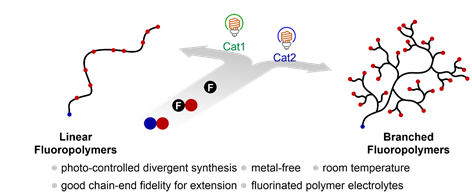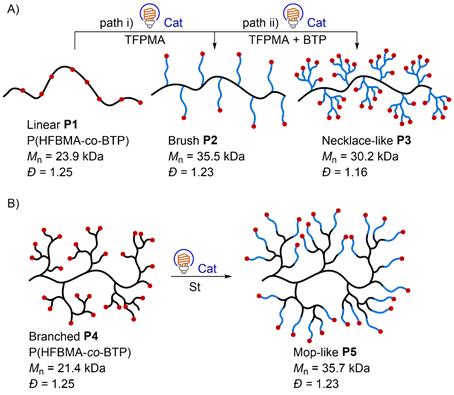 +565 975 658
+565 975 658
 info@premiumcoding.com
info@premiumcoding.com
 Monday - Friday, 8.00 - 20.00
Monday - Friday, 8.00 - 20.00
Topological structure has been considered as a key factor to determine physical properties of polymers, enabling their utilization for different purposes. For example, linear polymers are broadly used in plastics, and their branched counterparts are more suitable for lubricants, coatings, drug-delivery carriers and others. Recently, many discoveries have disclosed the potentials of topological control in high-end applications, and there is an increasing demand of innovating polymerization methods.
Generally, to provide polymers with different topologies, polymerizations were conducted using different formulations of starting materials (e.g., monomers, initiators/chain transfer reagents). For instance, monomers and ordinary initiators lead to linear polymers via reversible deactivation radical polymerization (RDRP). To synthesize (hyper)branched polymers, specific initiators/chain transfer reagents are usually required in RDRP.

Figure 1. Photoorganocatalyzed divergent reversible deactivation radical polymerization.
Recently, PolyMao Group developed a photoorganocatalyzed divergent RDRP driven by visible light that enables the controlled synthesis of both linear and branched fluoropolymers from the same starting materials (Figure 1). Polymers obtained by this method have controlled molecular weight, narrow molecular weight distribution,tunable degree of branching and glass transition temperature, as well as high chain-end fidelity. The site-specific initiation and controlled chain-growth achieved in this method facilitate the construction of hierarchically branched structures (e.g., necklace-like and mop-like fluoropolymers). (Figure 2).

Figure 2. Synthesis of fluoropolymers of various topologies via photoorganocatalyzed RDRP.
Recently, fluoropolymers have emerged as promising candidates for polymeric electrolytes, which are one of the key materials for the development of next-generation lithium-ion batteries. As demonstrated by P(HFBMA-co-BTP), it provides a new and versatile platform to access GPEs with improved lithium-ion transference number (0.63~0.72, Figure 3A). In the meantime, it is evident that the branched polymers delivered notably higher conductivity than the linear polymer electrolytes influenced by lowered Tg, and higher branching density was found to further increase the ionic conductivity (σ) (Figure 3B). For example, polymer of Sn = 5.6, provides the highest σ values (i.e., 1.04´10-3 S cm-1 at 25 °C).

Figure 3. Investigation on electrochemical properties. A) Li-ion transference number (t+) of PEO, linear and branched fluoropolymers. B) Temperature-dependent ionic conductivity (σ) of linear and branched fluoropolymers.
Given the broad applications of fluorinated materials and the significance of topological control in material engineering, this versatile synthetic method broadens opportunities to tailored fluoropolymers. This work has been published in the Angew. Chem. Int. Ed. (DOI 10.1002/anie.202009475). The authors are Yucheng Zhao, Mingyu Ma, Xinrong Lin, and Mao Chen.
See details: https://onlinelibrary.wiley.com/doi/epdf/10.1002/anie.202009475
More information of PolyMao Group, please check:
We are welcome for people with interests to contact us for joining our group (summer camp undergraduate, master, PhD or postdoctor).
Email: chenmao@fudan.edu.cn
Get to know us better now!

Wechat:FDUMMers
Search!
Search across our website
Revenant @ 2018 by fudan | All Rights Reserved
Powered by Weicheng

